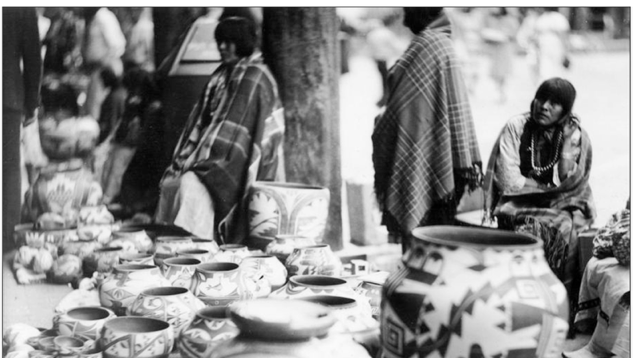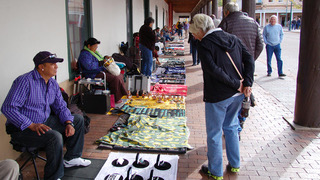Five minutes either way and we would have missed him. Just like the week before when, if we had turned away for a minute from the Netflix series we were viewing, we would missed the character and scene that introduced the story’s maguffin. And also (perhaps) gave one of us a subconscious tip on what to wear in the coming days . The show was “The Perfect Couple” based on a novel by Summer Beach Read Queen Elin Hilldebrand and starring Nicole Kidman. But the main person of interest to us in that particular scene was her “personal jeweler.”
Our real-life incident happened at one of the least shore-like spots in the world – the Santa Fe Botanical Garden – which we had decided to visit on a recent morning to take in some of the seasonal change in the floral landscape. We were walking along the upper level of its terraced garden-amphitheater when down below we saw what looked like a familiar face from our former home town of Wethersfield, CT. Like when you are a kid and see your teacher in the grocery store our first reaction was, “Nah. Couldn’t be.” But the more we looked… So we headed slowly down the stairs, still not certain, when he looked up, raised his arms and shouted, “Hey. I know you!”
As luck would have it (or perhaps it was predestined) Marsha was wearing a sliver and denim lapis necklace that N had designed and made for her to match a pair of earrings she had purchased in Marfa, TX. She also had on her 40th anniversary ruby bracelet (a gift from Jim) and her replacement-upgrade wedding ring, both of which were works of his. All of which he recognized and remembered. They were under time constraints so after a little more reminiscing, some vacation “gotta-see” tips from us newly-native northern New Mexicans and an exchange of contact info we said our good-byes – hoping that they return to see more of our new hometown. As we said earlier, “five minutes either way…”
But its not like there isn’t any jewelry in New Mexico.
As we learned quickly on our first visit in 1992 when wandered into Santa Fe Plaza and were introduced to the “Portal Program” of Native American artists under the portal of the Palace of the Governors (PotG) – an outgrowth of the weekly markets organized in 1936 by Maria Chabot, Executive Secretary for the New Mexico Association of Indian Affairs. Open daily, most vendors sell from 8:30 a.m. to 5 p.m. and all items (pottery, some textiles, and jewelry made of traditional materials such as turquoise, coral, and silver) are handcrafted by the seller or their household members. All the artisans are members of federally recognized New Mexican Tribes or Pueblos. And as we were told in 1992, “they don’t haggle but they do take MasterCard.”
Women selling pottery on Palace of the Governors portal during Indian Market, 1938.
Palace of the Governors Photo Archives No. 135047
Sad to confess however that we did not purchase any Indigenous accessories from the portal purveyors on that first trip. We are not recreational shoppers, Santa Fe was thick with tourists and the busyness of the PotG was a little too overwhelming for us. There were however other outdoor retailers of turquoise and silver scattered around-and-about the Plaza who had considerably less foot traffic and (at least to our uneducated eyes) good quality Native jewelry. (Or so they assured us.) Marsha found a silver and turquoise necklace for her initial piece of New Mexico jewelry.
Happy to say that over the 31 subsequent years of visits and re-lo to Santa Fe we feel that we have more than atoned for our initial avoidance of the Portal Market. As witnessed by a recent incident at that venue wherein a jeweler at whose work we were looking realized (with some emotion) that the earrings Marsha was wearing had been made by her father.
What we didn’t know until now was this...
“Jewelry making in the Southwest has a long history, and the Ancestral Pueblo people left behind elegant necklaces of black, white, red, and turquoise beads, as well as pendants and inlaid objects. Some of the most spectacular items were found in Chaco Canyon, New Mexico, in the site named Pueblo Bonito.” (ElPalacio.org)
However Indigenous Natives such as the Navajo (Diné) and Puebloans did not use silver in their jewelry until the Spanish introduced them to the idea in the mid 1800s – more than 250 years after the arrival of Spanish settlers in New Mexico. It began with the Navajos learning the craft of blacksmithing from Hispanic smiths in the villages of northwestern New Mexico, perhaps as early as the 1840s. During the next 20 years these newly trained “smithies” began applying their tools and skills to the production of silver jewelry – defining the designs and techniques of Navajo silver-work for decades. The tools of the earliest native silversmiths were primitive with most self-made from discarded scraps of iron and steel.
“The [Navajo] silversmithing process started by melting silver coins or other items in a pottery crucible or cupped piece of old iron placed on a charcoal forge made of mud. The smith puddled the molten silver into a simple mold to form an ingot or ‘slug.’ On an anvil consisting of a dense tree stump, hard stone, or piece of iron, he pounded the ingot into a thin silver sheet. Then using chisels or shears, he cut the desired shape from the sheet and hammered it to its final form. The smith then polished the silver with fine sand or ashes before a final buffing with buckskin.
“Silver craft spread quickly among the Navajo and Pueblo tribes … As the largest tribe in the region, Navajos dominated jewelry-making although a larger proportion of the Zuni population practiced the craft. Together the two tribes created the Indian jewelry legacy of the first half of the 20th century.” (medicinemangallery.com)
In spite of their common origins Zuni and Navajo jewelry have evolved into easily discernible styles. “If your jewelry has lots of silver and large unshaped stones, there's a good chance it's a Navajo piece. If it has smaller expertly cut stones, clusters of stones, or stone inlay, then there's a good chance it might be a Zuni piece.” (Palms Trading Company)
As can be seen in the Zuni Squash Blossom Necklace that Marsha purchased here in the 1990s. Santa Fe Plaza is surrounded by an array of stores selling Native American arts and crafts. One day, we walked that retail labyrinth on a mission to find a Squash Blossom necklace. We had not done any research so it was kind of learn as you go. And what we quickly realized was that her taste in squash blossoms was definitely not “lots of silver and large unshaped stones” but rather “smaller expertly cut stones.” Nor was it sales people who leaned in close, acted as if they were thinking deeply, wrote a number on a small piece of paper, looked you in the eyes and said, “for you” as they slid the note across the counter. Many of the necklaces being offered were delicate enough. Most of their prices were in the right ballpark. But that sales technique was not going to make a sale. Finally we found a necklace that checked all three boxes. And Marsha brought it home to Wethersfield. And then back out here where its style fits in better with the prevailing fashions.
Marsha enjoys harmonizing jewelry with her clothing – which meshes perfectly with the Santa Fe Style. And, as shown earlier, “you never know who you are going to meet.”
Another example.
A week after seeing N and family at the Santa Fe Botanical Garden the two of us were having breakfast at a favorite “French country style” restaurant in town and spotted actress Ali McGraw dining two tables away. It was our second sighting of her in our seven years here. And disappointingly she did not jump from her seat with arms raised and shout out, “Hey. I know you!” (We’ve been told that she has done similar things. While walking on on the sidewalk in Santa Fe a friend of a friend received a “looking good!” shout-out from Ms McGraw in her slowly-passing car.)
Maybe next time – perhaps at the Botanical Garden – and we, or at least one of us, will be dressed for it.





